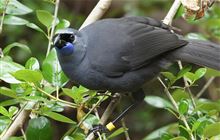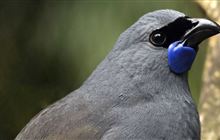Kōkako on the rise at Rotoehu
Introduction
Kōkako are “rapidly expanding” at Rotoehu Forest between Rotorua, Whakatāne and Te Puke according to a new survey of the birds.Date: 18 September 2023
The first survey in four years has revealed huge growth for the local population of the ancient wattle bird thanks to ongoing efforts to control introduced predators using bait stations and aerially applied 1080 bait pellets.
Rotoehu Forest is now home to New Zealand's second largest mainland kōkako population with 289 breeding pairs recently counted – an 89% increase on the 157 pairs in 2019.
The survey was done across 19 days in April by a team of seven experienced contractors with some support from volunteers to cover 2,450 hectares of public conservation land.
“This result is significant for the local population of kōkako and for the future of the species,” says Department of Conservation (DOC) Senior Ranger, Rebecca Newland.
Kōkako are a taonga for local iwi - Ngāti Mākino - and they hold a special place in the stories and traditional knowledge of the area.
Ngāti Mākino Iwi Authority is working alongside DOC to help protect kōkako and other native species at Rotoehu Forest.
“Preserving our native kōkako species is deeply rooted in our cultural and spiritual connection to the land and its environment, says Ngāti Mākino Tribal Authority Environmental Manager John Rapana.
“Over the centuries, observation of our kōkako and other manu taonga species resulted in an accumulation of local knowledge about their behaviour, habitat, and seasonal patterns that were observed, contextualised, and appropriated into our cultural stories and practises.
“From an iwi perspective, we are obligated to maintain our poutiaki role with our environment and its inhabitants. We must continue to develop multiple skill sets for our people to be confident and competent to undertake specialised roles to support our manu taonga and its environment.”
DOC will continue to use aerially applied 1080 bait in combination with a ground control programme lead by the local community to help kōkako and other native species in the area to breed. This includes kārearea, riflemen/titipounamu, kereru, bellbird/korimako, whitehead/pōpokatea, North Island robin/toutouwai, tūī, morepork/ruru and bats/pekapeka.
“The biggest threat to kōkako and many other native species is being killed by introduced predators including rats, stoats and possums,” Rebecca says.
“By regularly controlling these threats with a range of tools, native species including plants and insects have a much greater chance of survival. This creates the diversity ecosystems need to thrive.”
The Rotoehu Ecological Trust, which has managed bait stations in the forest since 2013, says the survey result is testament to the hard work of community volunteers and advocates who have strived to protect the forest for decades.
“We pay tribute to all who have gone before us in creating and maintaining the safe spaces in which this kōkako population has thrived,” says Trustee Jane Bird.
“In the late 1980s, protests by members of Forest and Bird Te Puke led to the creation of a protected conservation and ecological area, which was home to the ancestors of the current kōkako population.
“Since that time, many organisations have supported the population, and Rotoehu Ecological Trust/Kōkako Ecosanctuary is very fortunate to be assisting DOC with management of what is now a rapidly expanding kōkako population.”
The Trust hopes to install more bait stations in the forest to provide greater protection for kōkako living outside the 1,367-hectare area its members currently cover.
“We want to eventually cover 2000 hectares. To enable this, we need to secure funding from commercial and/or private sponsorship and we are calling out for help to protect future generations of kōkako,” Jane says.
There are more than 2000 kōkako breeding pairs in total throughout New Zealand with the population trend continuing to rise in areas with sustained predator control.
The largest mainland population is Pureora Forest (more than 600 pairs) followed by Rotoehu Forest (289 pairs) and the Hunua Ranges (over 250 pairs). Te Hauturu-o-Toi/Little Barrier Island also hosts a large population of more than 400 pairs.
Aerial 1080 predator control in Rotoehu Forest is part of DOC’s National Predator Control Programme.
The programme is protecting the remaining populations of threatened native species while tools continue to be developed to eradicate possums, rats and stoats by 2050.
Contact
For media enquiries contact:
Email: media@doc.govt.nz


